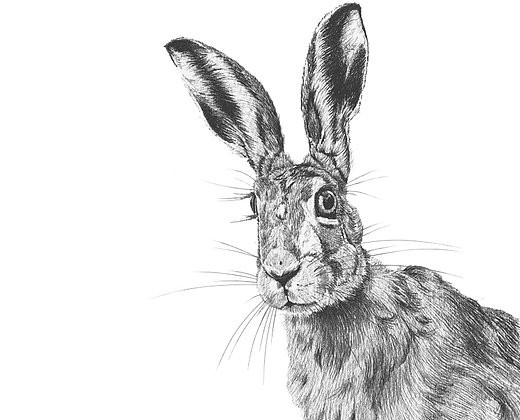Mad March Hares and The Easter Bunny
My earliest memories of Hares are from my Childhood, when my father would stop his tractor so we could see the snow covered fields come alive with the previously invisible Hares. They were so majestic, elegantly covering the ground at speeds not achievable by other farmland mammals. My father was always very precious about our Hare population. They lived on the farm in the over wintering corn fields, safe from poachers and protected as best he could from predation. In the mid 80s when I was a child, numbers of Hares were very low. The nationwide drop in numbers was attributed to the intensification of the agricultural industry, a by product of the introduction of the Common Agricultural Policy (CAP)– the Government initiative brought in during the 1950s, to feed the nation after the rationing and food shortages of World War II.
The plight of the Brown Hare was first highlighted back in the early 1990s, when it was one of the first animal species to be considered in the UK Biodiversity Action Plan (BAP). The UK BAP was the Governments response to the “Convention on Biological Diversity”, which the UK signed up to in 1992 at the Rio de Jenerio Earth Summit. The UK BAP described biological resources in the UK and detailed plans for their conservation.
Hares became a UK BAP priority species because of their significant decline from once being very common prior to World War II and subsequent post War agricultural intensification. It has been estimated that numbers dropped by about 75% during this period. However, with the introduction of BAP in the mid 1990’s, the shift in Agricultural support from production lead subsidies to more Agri-Environment focused and strategic financial support Brown Hare number are recovering. The majority of farmers now actively manage their farms and production systems to support target species such as the Brown Hare.
Today, it is a pleasure to walk the fields in East Shropshire (my home stomping ground) and see more Hares than I can hope to keep count of. Casting their magic over a new generation of countryside enthusiasts, and baffling many a gundog in the process.
These days I am just as interested in seeking why the sight of a Hare gives that feeling of magic to country folk. What is it that makes them so special? It is well documented that Hares have played a significant part in our culture and folklore for the last few thousand years, since their initial introduction to the UK by the Romans.
Could Hares association with magic be linked to the fact that they don’t burrow to hide from predators? Hares squat in shallow scrapes they have dug out in open fields giving the illusion of vanishing before your eyes. Hares have long been associated with witches, possibly because of their ability to seemingly ‘vanish’, or maybe due to their ‘mad March boxing’ antics which was describe by onlookers to be a witch’s dance. Witches were thought to be able to transform into Hares to flee from impending trouble. Hares have feature heavily in ancient folklore throughout our past, with many of their symbolism yet to be interpreted.
We’re all familiar with the Easter Bunny who comes along on Easter Sunday and hides chocolate eggs, but there is a theory that the Easter Bunny was in fact an Easter Hare! (This is my favourite Easter Bunny Theory): Hares do not burrow underground like rabbits; instead they crouch in ‘scrapes’ which are small dips they scrape in the earth. This gives Hares the optical illusion of simply disappearing when they run (in fact they just dip down into a scrape, lying flat). Ground-nesting birds, such as lapwings, were common before the intensification of agriculture, happily sharing their habitats with the Hares. However because of the Hares ability to seemingly disappear, when ancient people came to fields around Easter time (The first Sunday, after the first full moon after the Spring Equinox) they would find the eggs of a ground-nesting bird and believe it to have been left by the Hare. Or as they are called today, “The Easter Bunny”! If you want to read more about Easter and Eostre its pagan predecessor click through the link to an article written by Johnny Scott in The Field
We all remember the mad March Hare in Alice in Wonderland who attends the mad hatter’s tea party, but where does that concept come from? The idea of the ‘Mad March Hare’ comes from the Hare behaviour you’re most likely to witness in the month of March. The sort of behaviour you might see includes madcap chases and furious boxing matches. This is not ‘mad’ behaviour, but instead the courting behaviour of mating Hares. The boxing was commonly thought to be between two males battling over the favour of a female, however, they are more likely to be an unresponsive female fighting off a male’s advances.
The Brown Hare is one of the UKs farmland wildlife success stories. Numbers are recovering well thanks to the designation as a BAP priority species and the protection and support mechanisms funded through agri-environment schemes and the uptake of these schemes by farmers and land managers. The Game and Wildlife Conservation Trust have produced a fabulous booklet “Conserving the Brown Hare”, based on the scientific evidence they as a conservation charity have collected.

